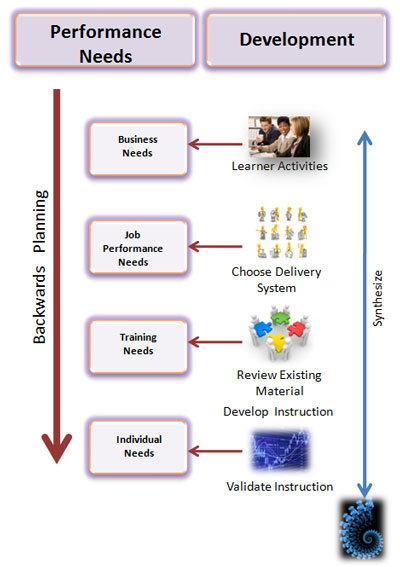Note: This site is moving to KnowledgeJump.com. Please reset your bookmark.
Developing Learning Processes
 In the fourth step of the Development phase, you elaborate and build the products called for in the Design phase blueprint. The finished product is often called courseware, content, instruction, learning activities, or learning platform.
In the fourth step of the Development phase, you elaborate and build the products called for in the Design phase blueprint. The finished product is often called courseware, content, instruction, learning activities, or learning platform.
Developing different forms of courseware, such as activities, media, and concepts require a certain amount of art and science. It is science as there is plenty of research that shows how people learn best and art because you are designing for the human element, for example, see ADDIE and the 5 Rules of Zen.

However, you should always concentrate on building learning activities that will give the learners real experience with the skills they need to perform, rather than simply telling and showing them information. Activities are participative learning experiences, such as exercises, role-plays, games, simulations, and reflective surveys that allow the learners to practice and reflect in order to master a skill.
Story telling (war stories) and group discussions are also great learning activities as they promote social learning.
Note that learning activities that promote experience should greatly outnumber content that is meant to be read or listened to.
Transforming Content into Experiences
Content that requires reading and listening should be limited so that the learners can spend time with more valuable activities that provide experiences, however, this type of content can be transformed into active learning, rather than passive learning.
van Merriënboer's 4C/ID Model, which was designed for training complex skills, provides a better way to present passive content through his deductive, inductive, expository, and inquisitory approaches. This method is shown in the third section, Approaches to Presenting Information and Examples at van Merriënboer's 4C/ID Model.
Designing Experiences
Rather than repeating other content on this site, please read these sections as they provide a lot of good information for designing and developing real learning experiences. Note that they are pretty much independent, so you can read them in just about any order; however, you should start with Introduction to Instructional Design (ID).
Instructional Design:
Developing eLearning
Working with Subject Matter Experts
In addition, other related learning and training material can be found on the Learning, Instructional Design, and Training homepage.
Next Steps
Go to the next section: Synthesize
Return to the Table of Contents
Pages in the Development Phase
-
Develop Instruction
